Developing Leaders Through Feedback
Collectively, companies spend billions of dollars for leader development, utilizing everything from public seminars to executive MBA programs at prestigious universities. While all of these have value, people sometimes overlook one of the simplest
Collectively, companies spend billions of dollars for leader development, utilizing everything from public seminars to executive MBA programs at prestigious universities. While all of these have value, people sometimes overlook one of the simplest tools, available free to everyone—real-time developmental feedback.
Some people believe, “if you screw up, I’ll let you know” is all the feedback people need. When we speak of feedback, we aren’t talking about giving compliments or criticism. To paraphrase a superintendent I met recently, we aren’t talking about “delivering a size 12 steel-toed message to a strategic anatomical location.” We aren’t even talking about an annual review process, which is a topic for another time.
Performance feedback is usually delivered with the intent of getting someone’s behavior or performance up to a basic minimum standard. “If you’re late one more time you won’t be working here anymore” is an example of direct performance feedback.
We think of feedback as a simple but powerful means of creating better leadership behaviors and actions through specific affirmations and precise course corrections. To that end we teach two kinds of developmental feedback—Plus and Delta. Plus, feedback means, “that’s really effective. Keep it up.” Delta (symbol for change) means, “You could be even more effective if….” Developmental feedback is always delivered with the intent of helping someone improve their performance.
The feedback loop is comprised of 3 steps. 1) Observation 2) Effect 3) Plan. Here’s an example.
-
A president of a specialty contractor observed his director of business development (BD) make a presentation to a prospective client that resulted in a lot of great questions and sustained dialogue.
-
The effect was they got a call the next day that they’d been selected for the work.
-
The plan for the BD guy going forward? Just keep creating well developed presentations and creating dialogues, not monologues.
Communicating this valuable information (along with a genuine “thank you”) took less than two minutes and was a powerful affirmation of great behaviors that will lead to continued success for the individual and the company.
I once asked a former big-league baseball catcher what’s going on when a catcher walks to the mound to talk with the pitcher. “It’s usually an issue of mechanics,” he said. Maybe his elbow is flaring a bit, or his windup is off, so his pitches are not quite where they need to be. He can’t see that kind of thing so I let him know what I’m seeing so he can make adjustments.” That’s about as good a definition as I’ve ever heard of feedback.
We’ve seen companies transform their culture by consistently giving (and receiving) Plus/Delta feedback, because people have clarity into which behaviors to continue, and which to alter. If you’re looking for an high return for a minimal investment with your leader development, you won’t do better than creating a culture of developmental feedback.
Published: April 29, 2019
IN THIS ISSUE
‘Smart’ Buildings Technology Growing More Common in HVAC Designs
Energy efficiency is not just about the environment, its about smart business. This Energy Efficiency Issue covers a myriad of energy efficient projects including Pittsburgh’s groundbreaking PNC Tower – and SMACNA contractors were there to bring it
A Green Roof Springs to Life
On top of a pharmaceutical company’s parking garage in Wilmington, Delaware, there grows a thriving patch of countryside, courtesy of SMACNA member Ernest D. Menold Inc.
Canadian Firm Revamps Plant Exhaust System
Trade-Mark Industrial Inc. of Cambridge, Ontario is flourishing in Canada’s booming economy. Trade-Mark has approximately 1,200 men and women in the field in locations as far west as Manitoba and the United States.
Developing Leaders Through Feedback
Collectively, companies spend billions of dollars for leader development, utilizing everything from public seminars to executive MBA programs at prestigious universities. While all of these have value, people sometimes overlook one of the simplest
Geauga Mechanical Contributes to Luxury High-Rise’s LEED Status
Expertise in energy efficiency and early involvement in the planning process were the keys to a successful residential – and landmark – project for Geauga Mechanical of Chardon, Ohio, according to CEO Craig Berman, LEED AP, CEM.
President’s Column: Building on the Benefits of Energy Efficiency
Today’s emphasis on energy management provides contractors with several opportunities to expand their businesses and help buildings become more energy efficient.
San Diego Crime Lab Requires Complex Systems
Associate Mechanical Contractors' complex HVAC system for the San Diego county Crime Lab helped it achieve LEED-Gold status.
SMACNA Endorses Bipartisan Bill to Speed Hospitality Retrofits
SMACNA has enthusiastically expressed support for the bipartisan bill, Restoring Investments in Improvements Act of 2019 (S. 803), which would amend last year’s Tax Cuts and Jobs Act to boost renovations and retrofits for restaurants and retailers.
Solar Power Harnesses the Sunshine
Roofs can serve multiple purposes besides being the foundation for green roofs. Harnessing the power of the sun, for instance, as a solar energy source for buildings and homes. Some SMACNA contractors are venturing into the solar market, offering
Testing and Balancing: Making a Difference in Energy Efficiency
SMACNA’s testing, adjusting, and balancing contractors are expanding their businesses by focusing on building systems and helping building owners and operators utilize their HVAC systems more efficiently.
University Innovation Center Designed for Collaboration
The roof and façade design for a new academic building project created “the perfect blend of high-tech and natural esthetics” for the University of Maryland’s new Brendan Iribe Center for Computer Science and Engineering, according to Scott Callaway


